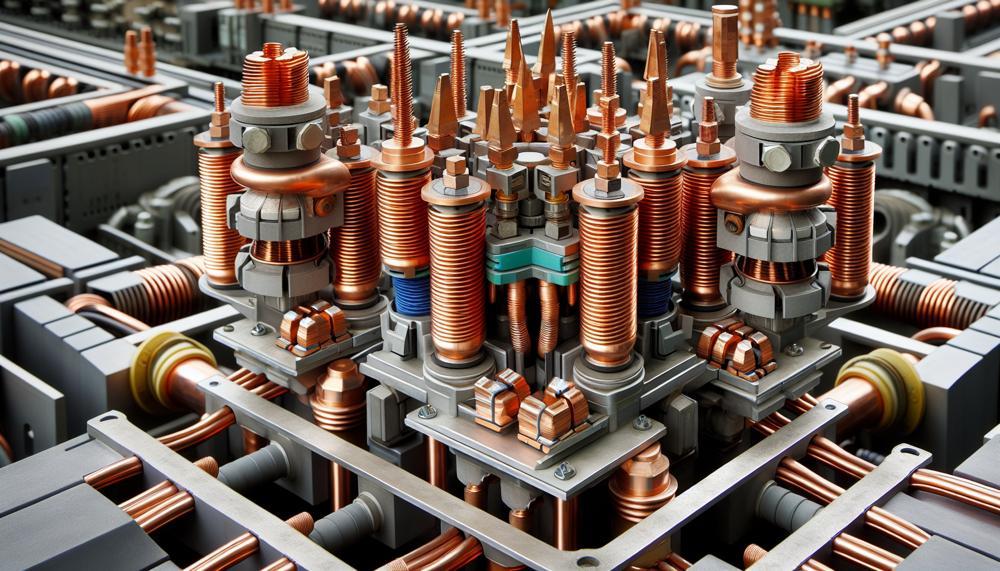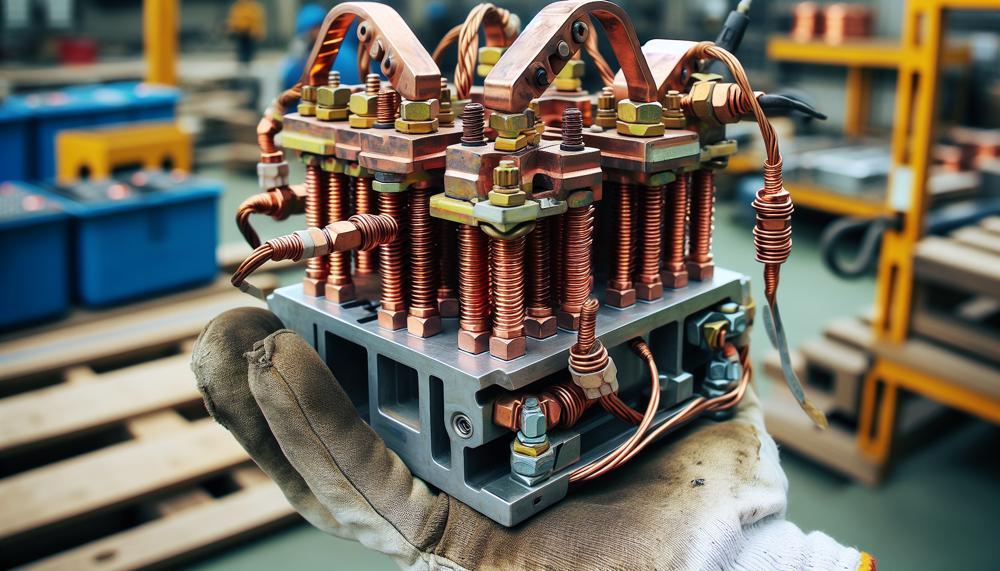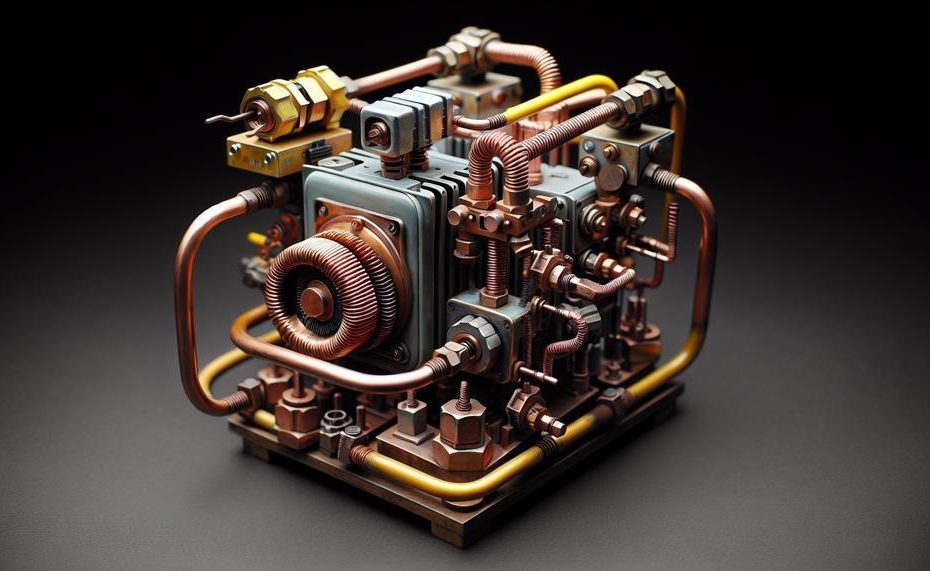Have you ever noticed those mysterious buttons or switches on a welding machine and wondered what they’re for? Well, my friend, let me introduce you to the world of taps on a welding transformer. Don’t worry if you’re not familiar with this concept – you’re not alone. But trust me, understanding the purpose of these taps will take your welding game to the next level.
So what exactly are these taps? In simple terms, they are like gears in a car, allowing for adjustments to the output voltage of a welding transformer. But unlike gears, these taps don’t just provide different speeds; they offer flexibility and control over the entire welding process.
Why is this important? Well, different types of welding require different voltage levels. For example, thicker materials need higher voltages while thinner ones require lower voltages. Taps make it possible to switch between these voltage levels seamlessly.
But that’s not all – taps also help compensate for voltage drops in long cables or when working with different materials. This feature ensures that the desired voltage reaches the welding electrode and produces consistent and quality welds.
You may be wondering how many taps there are on a welding transformer. The answer is – it depends. The number of taps can vary depending on the size and type of transformer. Some may have only two or three, while others can have up to 12 or more.
Now that we have a basic understanding of what taps do, let’s dive deeper into their importance.
So buckle up, grab your helmet, and get ready to explore the world of taps on a welding transformer.
Contents
- 1 The Basics of Welding Transformer
- 2 Understanding the Operating Principle
- 3 What are taps on a welding transformer?
- 4 Dive into the Construction of Taps
- 5 Locating the Taps in the Welding Transformer
- 6 Different Tap Designs in Welding Transformers
- 7 The Role of Taps in Voltage Adjustment
- 8 Getting to Know Tap Switches and Turns
- 9 Finding the Right Tap Setting
- 10 Conclusion
The Basics of Welding Transformer
There are three distinct types of taps located on a welding transformer, namely primary, secondary, and tertiary. Each tap serves a specific purpose and contributes uniquely to the welding process.
- Primary Tap: The primary tap is responsible for regulating the voltage output of the welding transformer. It allows for precise manipulation of the power flowing into the transformer, which ultimately influences the strength and intensity of the welding arc. Adjusting the primary tap not only ensures optimal welding results but also helps conserve energy and reduce electricity bills by using only the required amount of power.
- Secondary Tap: The secondary tap is responsible for controlling the current output of the welding transformer. It governs the intensity of the welding arc and can be adjusted to suit different welding tasks. For instance, thicker or harder materials may require a higher current output, while thinner or softer materials may need a lower current output.
- Tertiary Tap: The tertiary tap is responsible for fine-tuning the frequency output of the welding transformer. It regulates the frequency of the welding arc and can be used to adjust weld penetration and heat input. This tap is particularly useful when working with materials that require a specific frequency for optimal welding outcomes.
The various types of taps on a welding transformer are crucial to achieving successful welds. They allow for precise control over voltage, current, and frequency, which are crucial factors in creating strong and clean welds.
Properly adjusting these taps not only guarantees safety while working with electricity but also helps save on energy costs.
Understanding the Operating Principle
To understand the operating principle of using taps on a welding transformer, we must first recognize their function in controlling the flow of electricity. Taps allow for precise adjustments to be made to the voltage, current, and frequency, which play a crucial role in achieving optimal welding results.
By changing the primary tap on the transformer, one can control the voltage output. This is essential because different materials require different levels of voltage for efficient welding. Too much voltage can cause burn-through, while too little can result in poor penetration.
Similarly, the secondary tap on the transformer controls the amperage output, which is crucial for achieving a stable and consistent arc. By adjusting the current, welders can produce stronger and higher-quality welds.
In addition, the tertiary tap on the transformer regulates the frequency of electricity flowing through it.
This affects the arc stability and reduces spatter, resulting in a smoother and cleaner weld.
What are taps on a welding transformer?
A welding transformer has taps on the secondary coil that let you connect the welding line and change the amount of current going through it.
With taps, you can change the voltage ratio and the coil ratio. This lets you change the output voltage if the input voltage isn’t the same as the standard voltage.
People often use the taps on a welding generator to:
- Give a large-scale change to the welding current
- Change the secondary voltage
- Adjust any input levels that are too high or too low.
On the windings of the transformer’s main side is where the transformer tap switch is located.
Tap 1 will always have the least amount of electricity and power. There are five tap settings on most distribution transformers, with two taps set 2.5% above and below the standard label voltage value.
Dive into the Construction of Taps
The construction of taps on a welding transformer is composed of two crucial components: the primary and secondary taps. These taps are precisely calculated and positioned to provide specific voltage levels, serving as a critical factor in achieving optimal welding performance.
By regulating the voltage, they aid in stabilizing the arc during welding and ensuring that the correct amount of power is delivered to the welding process. Moreover, the presence of multiple taps offers flexibility in voltage selection, leading to enhanced quality and efficiency in the welding process.
The strategic placement and function of these taps contribute significantly to the overall functionality and success of the welding process, allowing for better control and customization for welders.
Without a doubt, the taps on a welding transformer play an irreplaceable role in voltage and current regulation, making them a vital component for any welding project.
Locating the Taps in the Welding Transformer
When searching for the taps on a welding transformer, it is crucial to understand the three types: primary, secondary, and tertiary. The primary tap regulates voltage output, while the secondary tap adjusts current output.
The tertiary tap controls the frequency output. Depending on the welding machine’s size and model, these taps can be found on the side or top of the transformer and can vary in number.
To identify each tap, you can refer to the transformer’s manual or specifications sheet. Alternatively, you can visually inspect the transformer for labels or markings that indicate its type and function. Once identified, you can securely connect each tap to its respective power source using proper electrical connections and safety precautions.
Working with welding transformers and their taps requires caution as they involve high voltage and current. Always follow safety procedures and guidelines to prevent accidents or injuries.
In the event of any issues with the taps, such as decreased performance or complete failure, it is essential to troubleshoot the problem. This may include checking for loose connections, damaged wires, or components and making necessary repairs or replacements.
Locating the taps on a welding transformer is crucial for achieving precise control over voltage, current, and frequency in the welding process.
Proper identification and connection of taps can also help reduce electricity bills by minimizing power consumption.
Different Tap Designs in Welding Transformers
The welding transformer has three different tap designs: primary, secondary, and tertiary. Each tap serves a specific purpose that impacts the welding process.
- Primary tap: This tap is responsible for adjusting the voltage output of the welding transformer. By changing the number of windings on the primary coil, the voltage output can be increased or decreased. This allows for precise control over the heat input to the weld, resulting in optimal outcomes for various welding jobs.
- Secondary tap: Adjusting the current output of the transformer is the main function of the secondary tap. By altering the number of windings on the secondary coil, the amperage output can be adjusted. This is crucial for controlling heat and penetration during welding.
- Tertiary tap: The tertiary tap is responsible for regulating the frequency output of the transformer. Changing the number of windings on the tertiary coil can increase or decrease the frequency of the welding arc. This is especially important when working with materials like aluminum, which require a higher frequency to achieve strong welds.
These different tap designs in a welding transformer have a significant impact on the welding process by providing precise control over voltage, current, and frequency. This not only results in high-quality welds but also ensures efficient use of electricity.
Furthermore, taps also serve to protect equipment by ensuring that the correct amount of electricity is used for each job.
It is crucial to regularly check for loose connections or incorrect wiring to avoid faulty taps, which can lead to decreased performance or even failure.
The Role of Taps in Voltage Adjustment
In welding transformers, taps play a crucial role in controlling voltage, current, and frequency. They provide precise adjustments to match different welding job requirements, resulting in strong and efficient welds.
While primarily used for voltage adjustment, taps also assist with current and frequency control, making them a versatile tool for welders.
How Taps Help with Voltage Adjustment:
Taps on a welding transformer allow for precise adjustments to be made to ensure the welding arc operates at the optimal voltage for each specific job. By fine-tuning the voltage, welders can control heat output and penetration depth, resulting in better quality and stronger welds.
This is especially important when working with varying materials or thicknesses that require specific voltage levels for optimal results.
Types of Taps:
Welding transformers typically have three types of taps: primary, secondary, and tertiary. The primary tap adjusts the primary voltage to ultimately control the secondary voltage. The secondary tap regulates the secondary voltage, while the tertiary tap adjusts frequency. By utilizing these different taps, welders can fine-tune their settings to meet the specific requirements of each welding job.
Benefits of Using Taps:
Taps offer more than just precise voltage adjustments during the welding process. They also help regulate current and frequency levels, resulting in more efficient electricity usage and cost savings on bills.
Additionally, taps protect equipment from damage by providing control over amperage and duty cycle.
Safety Precautions:
It is crucial to take safety precautions when working with welding transformers and their taps. Regular maintenance checks are necessary to ensure that faulty or damaged taps do not lead to decreased performance or failure.
In case any issues arise, they can usually be troubleshooted and rectified without needing to replace the entire transformer.
Choosing the Right Tap:
When selecting a tap for a welding project, factors such as material, hardness, thread pitch, size, length, and type of flutes must be considered.
The right tap should be able to handle the required voltage and current levels for the job, while also being compatible with the welding transformer.
Getting to Know Tap Switches and Turns
Tap switches and turns are vital components of a welding transformer, allowing welders to finely tune voltage, current, and frequency output for optimal results. These switches and turns give welders more control over their output, allowing for precise adjustments as needed.
They also play a crucial role in reducing power consumption and protecting equipment from damage.
In the welding process, tap switches and turns have several important functions. Firstly, they aid in creating a strong connection between two pieces of metal by adjusting the voltage output. This is crucial to achieving high-quality welds that are strong and durable.
Additionally, these switches and turns can reduce spatter and improve arc stability by adjusting the frequency of the welding current.
Moreover, tap switches and turns provide precise control over amperage output, ensuring an efficient welding process.
By adjusting the current, welders can achieve better penetration and control over the weld pool. This is particularly important when working with different materials or thicknesses.
Another key aspect of tap switches and turns is their ability to control the duty cycle of a welding transformer. The duty cycle refers to the amount of time a welding transformer can operate without overheating.
By controlling the duty cycle, these switches and turns prevent overheating and prolong the life of the transformer.
Finding the Right Tap Setting
When it comes to selecting the right tap setting for your welding transformer, there are several important factors to consider. These include the type of welding, the type of metal being welded, and the thickness of the metal. Each of these factors plays a crucial role in determining the appropriate tap setting for optimal results.
- Identify the type of welding: First and foremost, you need to determine the type of welding process being used. This will have a significant impact on the recommended tap setting. For example, AC welding typically requires a lower tap setting compared to DC welding.
- Determine the type of metal: The type of metal being welded also plays a vital role in selecting the right tap setting. Different metals have varying electrical resistances, which means that they require different levels of current and voltage to achieve a proper weld.
- Consider the thickness of the metal: When it comes to thicker metals, it is essential to use higher tap settings to ensure proper fusion. Matching the tap setting with the thickness of the metal being welded is crucial for achieving optimal results.
- Refer to the manufacturer’s recommendations: To make things easier, every welding transformer comes with a manual that provides recommended tap settings for different types of welding and metals. It is crucial to refer to these guidelines when setting up your welding transformer.
- Experiment with different settings: Keep in mind that not all welding jobs are the same. It may take some trial and error to find the perfect tap setting for your specific project. Start with the recommended settings and make adjustments as needed until you achieve a smooth and efficient weld.


| Factors | Tips |
| Type of Welding | AC welding typically requires lower tap settings compared to DC welding. |
| Type of Metal | Different metals have varying electrical resistances, which means they require different levels of current and voltage. |
| Thickness of Metal | Thicker metals require higher tap settings for proper fusion. |
| Manufacturer Recommendations | Refer to the manual for recommended tap settings for different types of welding and metals. |
| Experimentation | Not all welding jobs are the same, so it may take some trial and error to find the perfect tap setting for your specific project. |
Conclusion
In conclusion, the taps on a welding transformer are comparable to gears in a car, providing the necessary flexibility and control for a successful welding process. These taps allow for adjustments to voltage, current, and frequency levels, ensuring optimal results for different types of welding and materials.
By understanding the role of primary, secondary, and tertiary taps, welders can fine-tune their settings to achieve strong and efficient welds. While the number of taps may vary depending on the size and type of transformer, their importance remains constant.
With precise control over electricity flow, tap switches and turns also protect equipment from damage and reduce power consumption.
But these taps are not just mere buttons or switches; they hold the key to unlocking your welding potential.
Like a skilled driver shifting gears at just the right moment, welders must select the appropriate tap setting based on factors such as the type of welding, the metal being welded, and the thickness of the metal.
Through experimentation and reference to manufacturer recommendations, you can find the perfect tap setting for each unique project.





